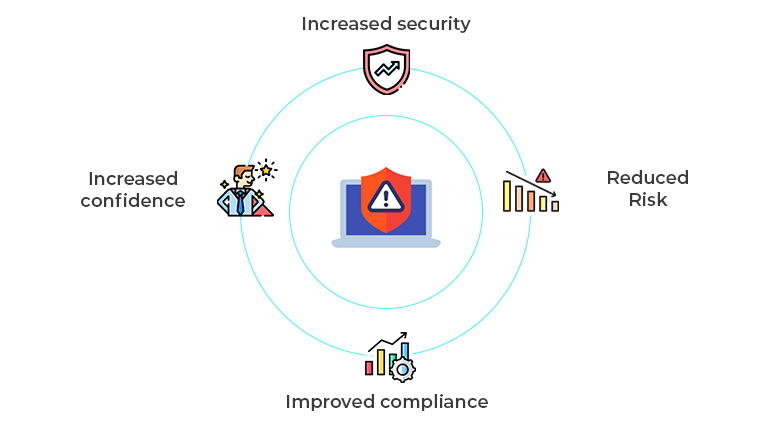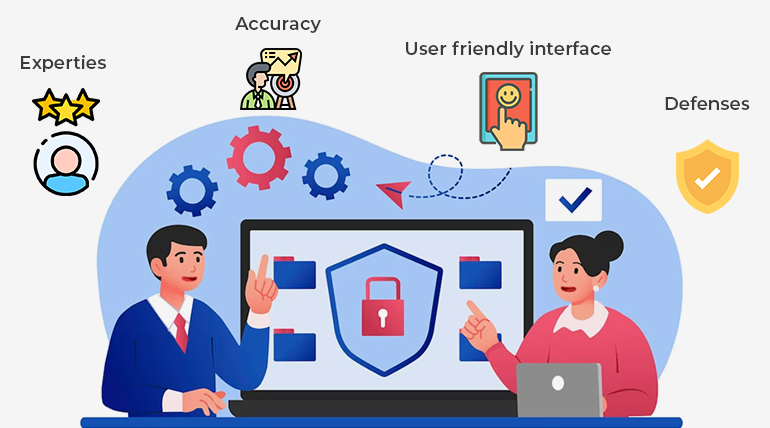Unveiling the Hidden Dangers: Exploring Network Vulnerabilities
In today’s digital age, businesses face a relentless onslaught of cyberattacks. And with over 9.2 billion attacks in 2022 alone, every minute counts. Enter the network vulnerability assessment—a vital tool to identify and fix security weaknesses. It is like shining a light into a dark alleyway. It can help you identify and fix security weaknesses in your network, so you can protect your business from cyberattacks.
In this blog, we explore its importance, what happens if you miss it, and provide tips for choosing a reputable security firm. Don’t wait—let’s navigate this dark alleyway and safeguard your business together.
What is a Network Vulnerability Assessment?
Network vulnerability assessments are like a security checkup for your business. They help you identify and fix weaknesses in your network before hackers can exploit them. This can prevent cyberattacks, which can cost you money, damage your reputation, and even steal your customers’ data.
If you’re serious about protecting your business, then you should get a network vulnerability assessment. It’s one of the best ways to stay safe in today’s digital world.
Why Do You Need Network Vulnerability Assessment?

Your Business is Under Attack
Hackers are determined to steal your data, your money, and your customers. Remember the massive WannaCry ransomware attack in 2017? It affected over 200,000 computers across 150 countries and caused an estimated $4 billion in damages.
Shockingly, this attack could have been prevented if the affected businesses had conducted a thorough network vulnerability analysis and addressed the security weaknesses that the hackers exploited.
According to the Ponemon Institute, the average cost of a data breach is a staggering $3.86 million. Businesses that neglect network vulnerability testing are at an even higher risk of incurring these costs. But here’s the good news: you have the power to protect yourself.
But there’s something you can do to protect yourself.
By investing in network vulnerability assessments, you significantly reduce the risk of being hacked and the potential financial impact of a data breach. This proactive step helps safeguard your data, preserve your reputation, and protect your bottom line.
So, what can you expect from a network vulnerability assessment?
- A comprehensive network vulnerability assessment report that highlights your network’s security weaknesses.
- Tailored recommendations on how to address these vulnerabilities effectively.
- The ability to fortify your network’s defenses and gain peace of mind knowing that your business is well-protected.
Armed with this knowledge, you can fortify your network’s defenses and gain peace of mind knowing that your business is well-protected.
Consider these eye-opening statistics:
- In 2021, there were over 623 million cyberattacks worldwide.
- The most common types of cyberattacks include phishing attacks, malware attacks, and ransomware attacks.
- A staggering 90% of cyberattacks start with a phishing email.
- 70% of hacked businesses end up closing their doors within just six months.
Curious to know in detail what happens when Network vulnerabilities are ignored? Read on.
What Risks Do Network Vulnerabilities Cause?

The Cost of Network Vulnerabilities
The cost of network vulnerabilities can be high. In 2022, the average cost of a data breach was $4.24 million. This is up from $3.86 million in 2021. The cost of a data breach can be even higher for certain organizations, such as healthcare organizations, which can experience average costs of $7.1 million.
In addition to the financial costs, data breaches can also have a significant impact on an organization’s reputation and customer base.
- 61% of organizations that experience a data breach suffer a loss of revenue.
- 52% of organizations that experience a data breach suffer a loss of customers.
- The average time to identify a data breach is 207 days.
- The average time to contain a data breach is 73 days.
The Risks of Network Vulnerabilities
Network vulnerabilities can pose a number of risks to businesses, including:
- Data breaches: Hackers can gain access to sensitive data, such as customer information, financial data, and intellectual property.
- System disruptions: Hackers can disrupt operations by taking down websites, disabling systems, and stealing data.
- Reputational damage: A data breach can damage a business’s reputation and make it difficult to attract customers and partners.
- Legal liability: Businesses can be held liable for the damage caused by a data breach.
Picture this
There is a small business, full of promise and ambition, suddenly falling victim to a devastating cyberattack. Sadly, this scenario is all too common. Startling statistics reveal that 60% of small businesses that experience a cyberattack are forced to shut their doors within a mere six months.
The financial strain and reputational damage inflicted by such breaches can be insurmountable, leaving entrepreneurs shattered and dreams shattered.
But it’s not just small businesses that face the wrath of network vulnerabilities. Even global corporations, seemingly invincible, can come crashing down when these vulnerabilities are exploited. It’s crucial to address network vulnerabilities proactively through network vulnerability analysis, testing, and assessment.
Now Imagine
A renowned company, trusted by millions, whose negligence allowed a massive data breach to occur. The fallout was catastrophic—millions of customer records were compromised, a tarnished brand image, and a staggering multimillion-dollar settlement that shook the very foundations of the organization.
The repercussions were far-reaching, leaving a scar that may take years to heal.
But when you take proactive steps, your network vulnerability assessment report will provide valuable insights to strengthen your security and ensure the long-term success of your business.
How Cybercriminals Exploit Network Vulnerabilities
Unpatched Vulnerabilities
Malicious actors are always looking for ways to exploit network vulnerabilities. One of the most common ways is to exploit unpatched vulnerabilities. Unpatched vulnerabilities are security flaws in software that have not been fixed by the software developer.
Brace yourself as we shed light on some of the notable techniques employed by these cunning individuals to exploit network vulnerabilities.
Zero-Day Vulnerabilities
Imagine a ticking time bomb, waiting to detonate within seconds. That’s the reality when it comes to unpatched vulnerabilities. In a mere blink of an eye, cybercriminals can exploit an unpatched vulnerability, infiltrating your network and gaining unauthorized access to your most sensitive information.
The window of opportunity is incredibly small, averaging just 7 seconds, leaving organizations with limited time to respond and mitigate the potential damage.
Another chilling example
Now, picture a renowned social media platform loved and trusted by millions of users worldwide. Suddenly, a dark cloud looms over its reputation as hackers exploit a zero-day vulnerability, a flaw unknown to the platform’s developers.
With this weapon in hand, cybercriminals infiltrate the platform, compromising millions of user accounts and wreaking havoc on the digital lives of unsuspecting individuals. Trust is shattered, and the platform’s once-loyal user base suffers a severe blow.
These examples serve as scary reminders of the exploitation techniques employed by cybercriminals.
What Are Common Network Vulnerabilities?
In the ever-evolving landscape of cybersecurity, knowledge is power. To fortify your organization’s defenses, it’s essential to familiarize yourself with the common adversaries that leave your network susceptible to attacks.
Let’s shine a spotlight on some of the most prevalent vulnerabilities that pose an incessant threat to your network security.
Misconfigured Network Devices: A Common Nemesis
Imagine a maze filled with pitfalls, and lurking within are misconfigured network devices—a common nemesis responsible for a staggering 80% of all network vulnerabilities. Routers and firewalls, when not properly configured, become open invitations for cybercriminals to slip past your defenses.
The critical need for robust configurations and ongoing monitoring cannot be emphasized enough. By ensuring that your network devices are finely tuned and fortified, you close the door on potential threats and take a proactive stance against those who seek to exploit vulnerabilities.
Outdated Software Vulnerabilities: A Silent Assassin
Now, turn your attention to a hidden danger that continues to haunt organizations—the specter of outdated software vulnerabilities. Shockingly, over 50% of reported breaches are attributed to unpatched applications and operating systems.
Picture a silent assassin lying in wait, ready to strike when you least expect it. Failing to keep your software up to date leaves your organization exposed, a vulnerable target for cybercriminals seeking easy prey.
Embracing Timely Patching and Software Updates
By embracing the importance of timely patching and software updates, you close the gap through which they can infiltrate your network, ensuring that your organization remains secure and impervious to their advances.
How Do I Prevent Exploitation?
In the relentless battle against cyber threats, prevention reigns supreme. To safeguard your network infrastructure and thwart the exploitation of vulnerabilities, it’s crucial to embrace proactive measures that significantly reduce the risk of falling victim to cyberattacks.
Let’s explore some powerful strategies for preventing the exploitation of network vulnerabilities and ensuring your organization’s digital fortress remains impregnable.
5 Ways to Prevent Data Breaches
- Implement a comprehensive vulnerability management program. This includes regularly identifying and patching vulnerabilities, as well as fortifying your network’s resilience.
- Implement strong access controls. This includes using passwords, multi-factor authentication, and other methods to restrict access to sensitive data.
- Educate your employees about cybersecurity risks. This includes teaching them how to identify and avoid phishing scams, as well as other common cyberattacks.
- Keep your software up to date. Software updates often include patches for security vulnerabilities. By keeping your software up to date, you can help to protect your network from exploitation.
- Have a disaster recovery plan in place. This will help you to recover quickly from a data breach, minimizing the damage.
By following these tips, you can help to prevent data breaches and protect your organization from cyberattacks.
Here are some additional tips to help you prevent data breaches:
- Use strong passwords and change them regularly.
- Be careful about what information you share online.
- Don’t open emails from unknown senders.
- Install a firewall and antivirus software.
- Keep your software up to date.
- Educate your employees about cybersecurity risks.
What are the benefits of having a network vulnerability assessment?

There are many benefits to having a network vulnerability assessment, including:
- Increased security: A network vulnerability assessment can help businesses identify and fix security weaknesses, which can help to prevent cyberattacks.
- Reduced risk: By reducing the number of security weaknesses, businesses can reduce the risk of being hacked.
- Improved compliance: Many industries are required to comply with security regulations, such as PCI DSS and HIPAA. A network vulnerability assessment can help businesses to demonstrate compliance with these regulations.
- Increased confidence: A network vulnerability assessment can give businesses confidence that their networks are secure.
How to Get a Super Secured Network Vulnerability Assessment

When it comes to acquiring a network vulnerability assessment, choose the path of excellence and distinction. Consider the following:
Partner with Beyond Key, a trailblazer in cybersecurity. Here is why.
- Benefit from our years of expertise in vulnerability assessment services.
- Access a team of seasoned professionals armed with cutting-edge tools.
- Experience meticulous assessments that leave no vulnerability undiscovered.
- Receive actionable recommendations for fortification and mitigation.
Explore reputable automated tools designed for network vulnerability assessments.
- Select solutions known for reliability and accuracy.
- Look for user-friendly interfaces that simplify the assessment process.
- Assess vulnerabilities with ease and make informed decisions to bolster your defenses.
Remember, the significance of selecting a reputable partner or tool cannot be overstated. Safeguard your organization’s digital assets by choosing our exceptional capabilities and trusted automated tools.
Empower your organization, fortify your digital fortress, and confidently navigate the evolving landscape of cybersecurity.
Conclusion
Network vulnerability assessments are an essential part of any comprehensive cybersecurity strategy. By conducting regular assessments, businesses can identify and address security weaknesses before they are exploited by hackers. This can help to prevent costly data breaches and protect businesses from other serious consequences of cyberattacks.
If you are curious to secure your business, I encourage you to learn more about network vulnerability assessments here and consider having one conducted for your organization. It is an investment that could save you a lot of time, money, and headaches in the future.
Stay one step ahead of cyber threats by embracing prevention and forging strategic partnerships. And with us, you can unlock the true potential of your network vulnerability assessment. Let’s safeguard your digital fortress!
















